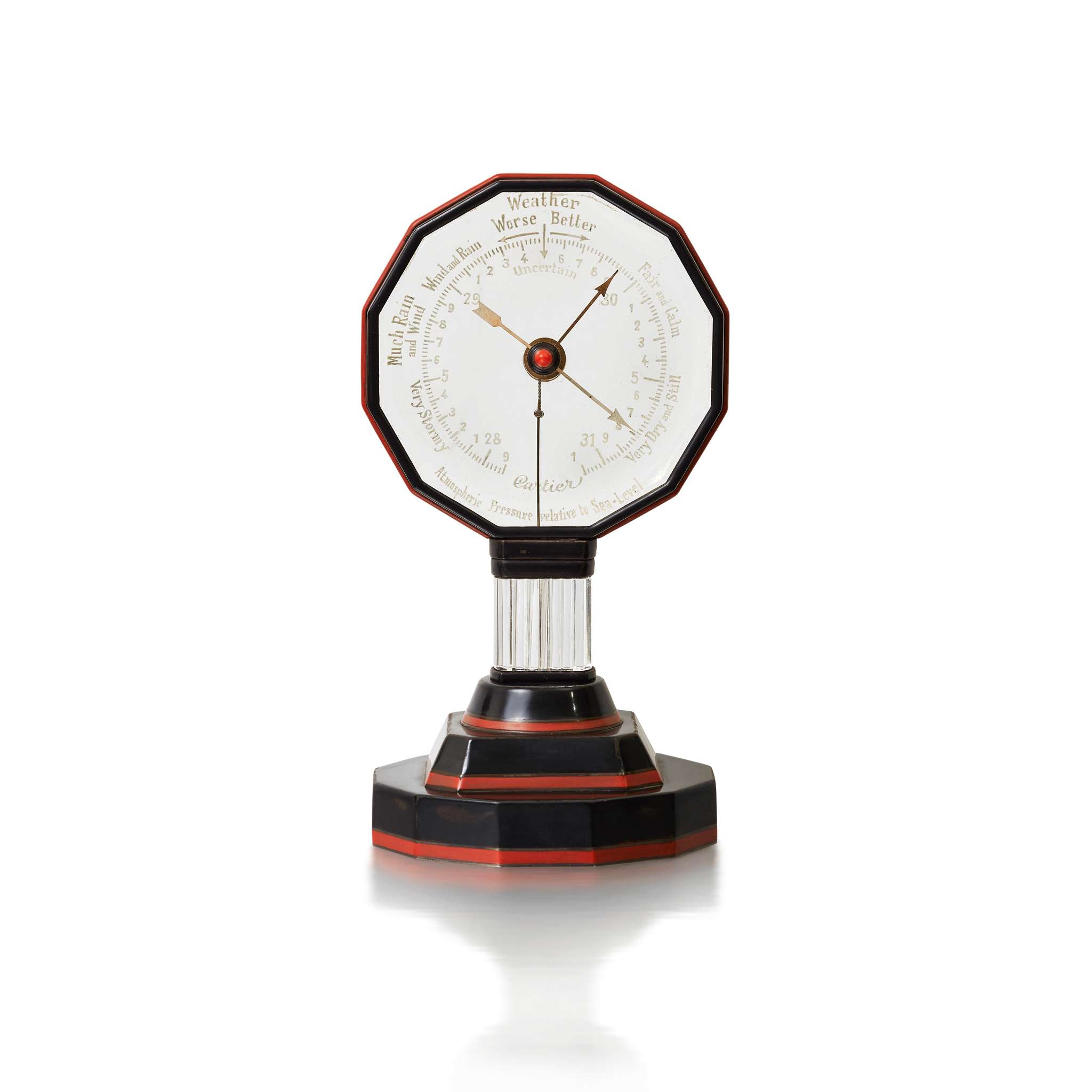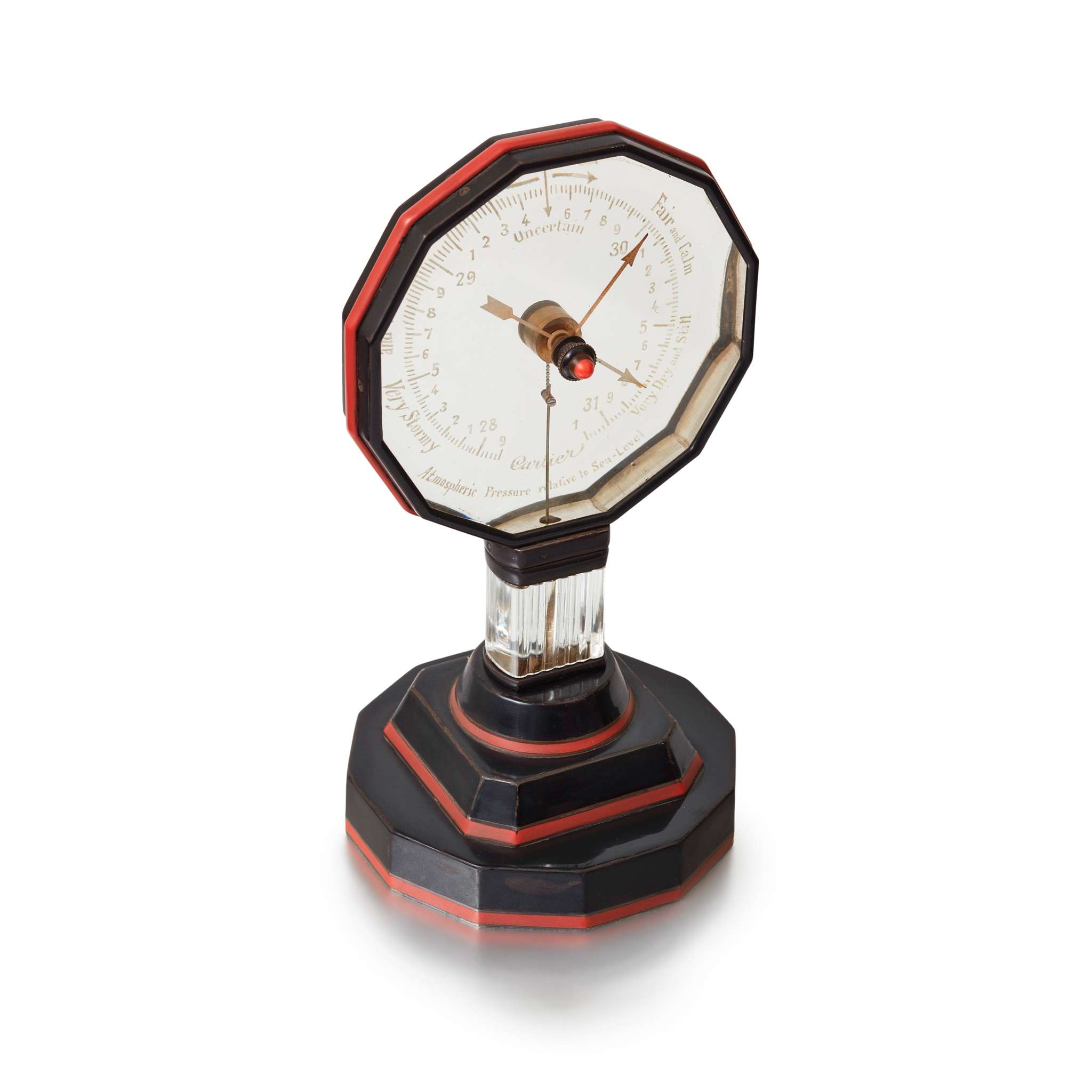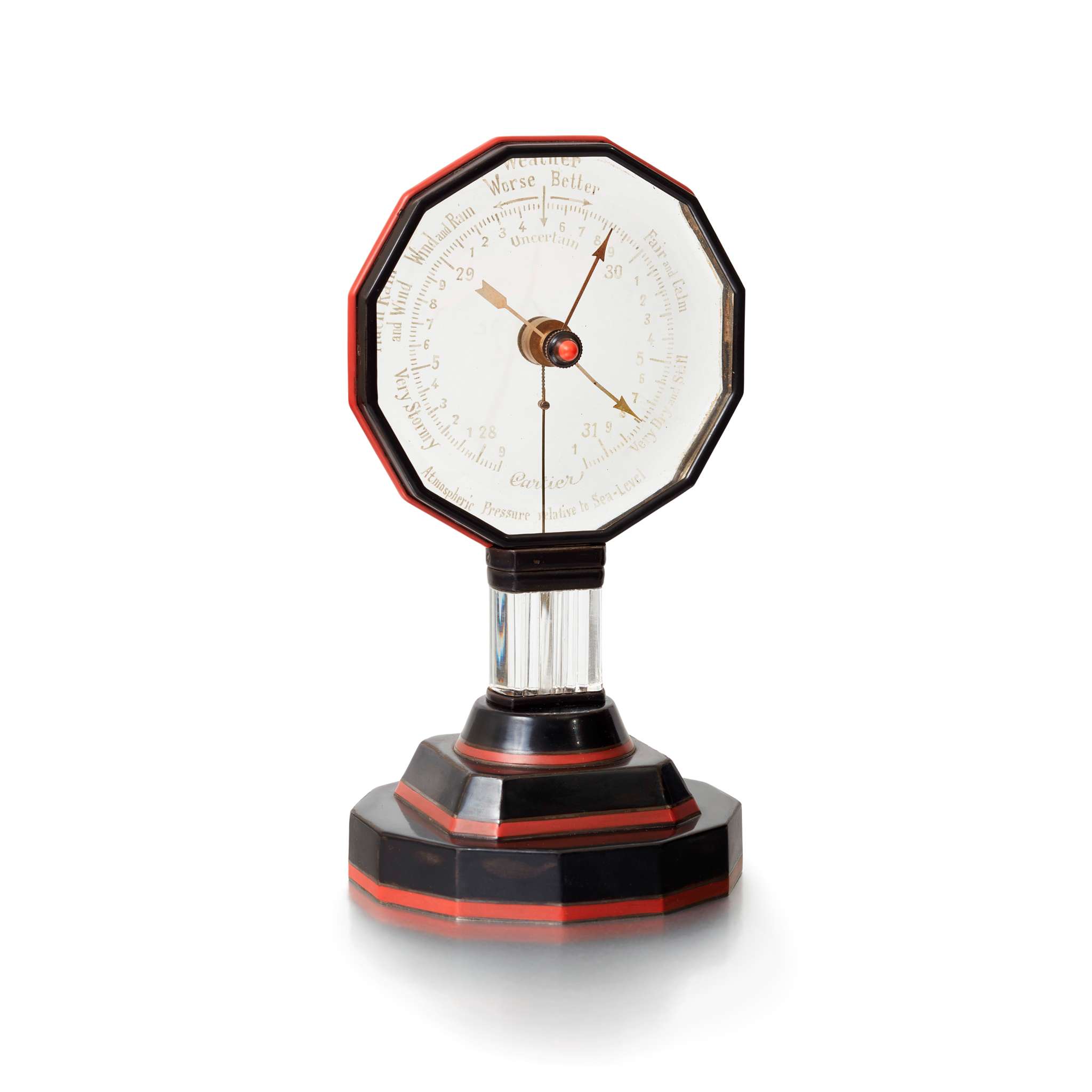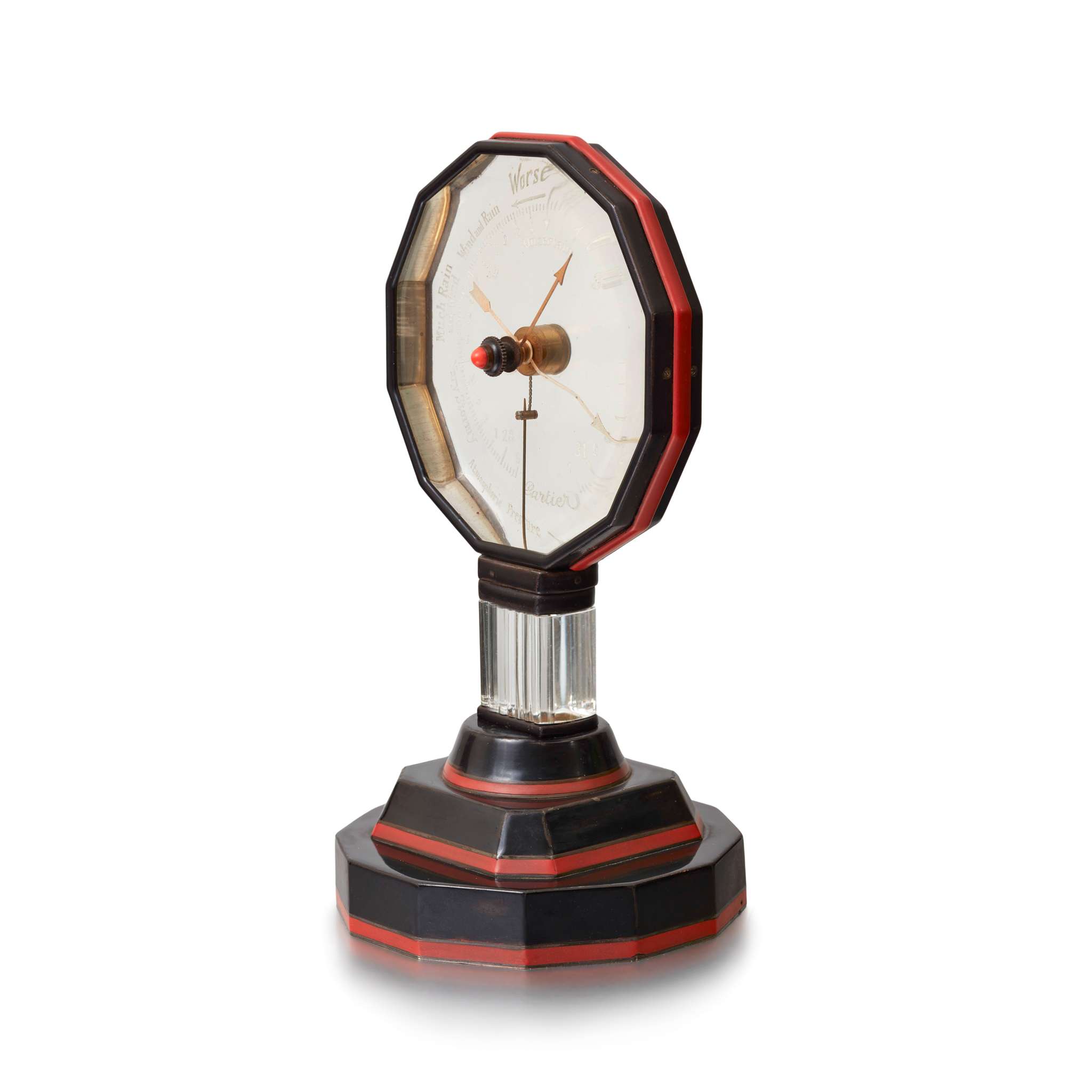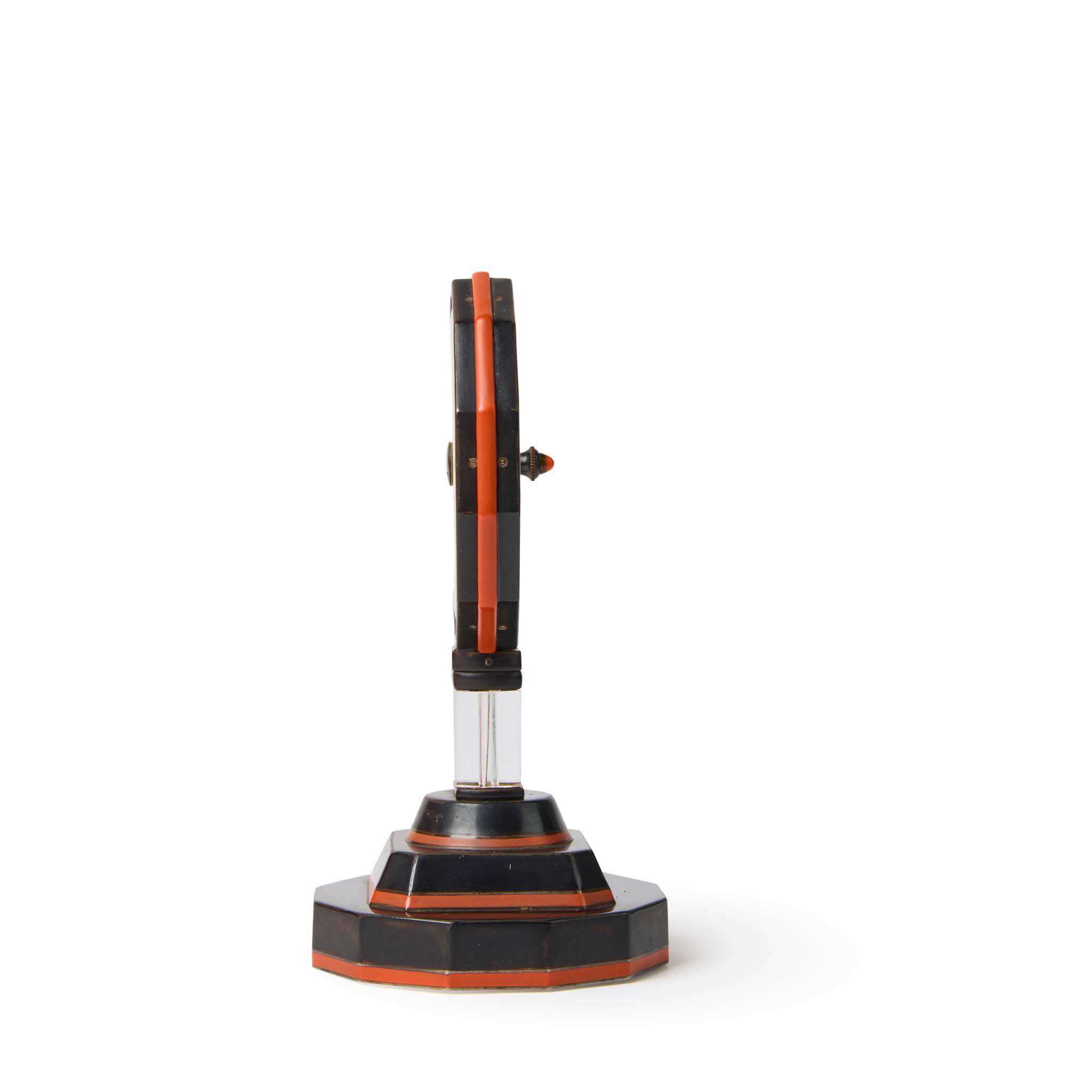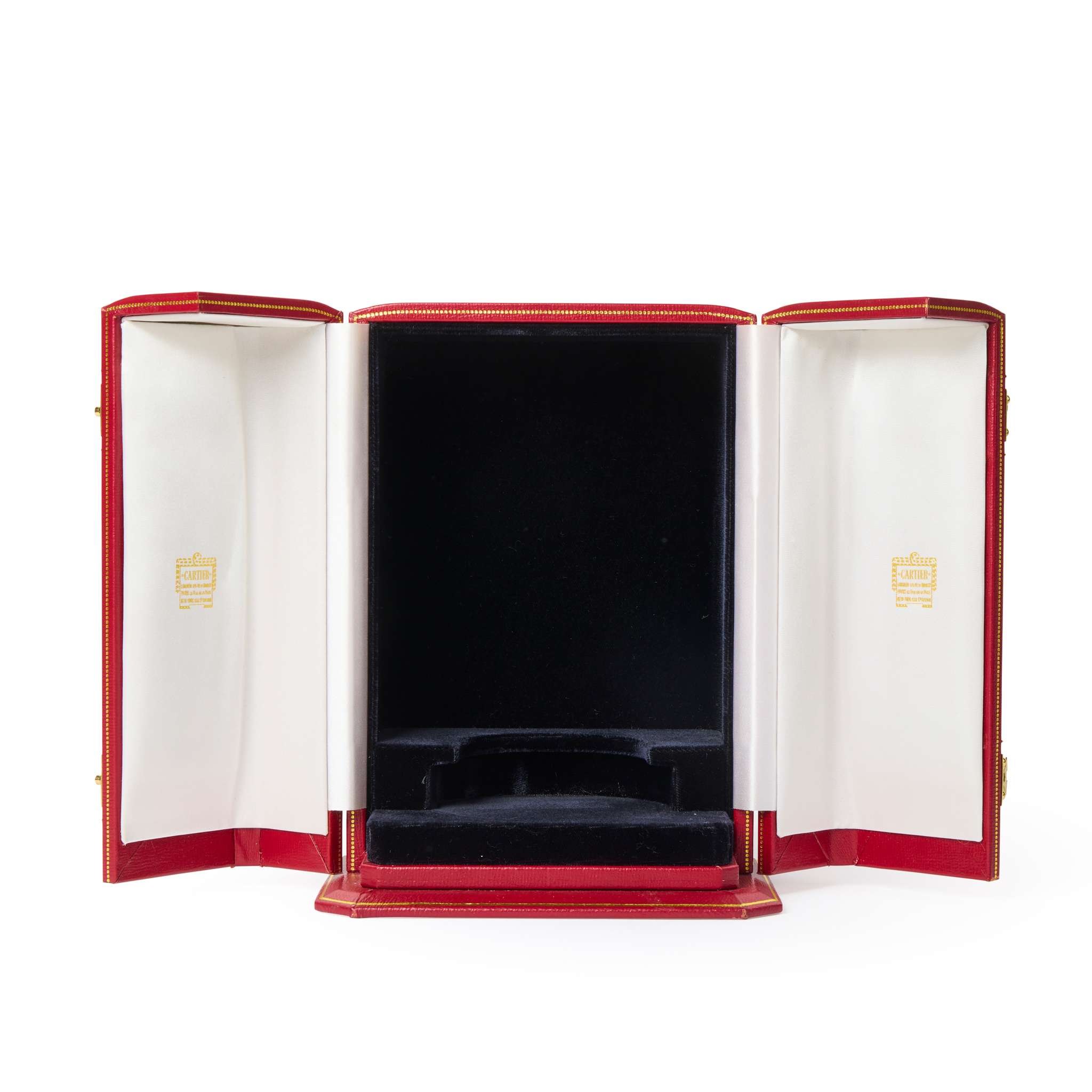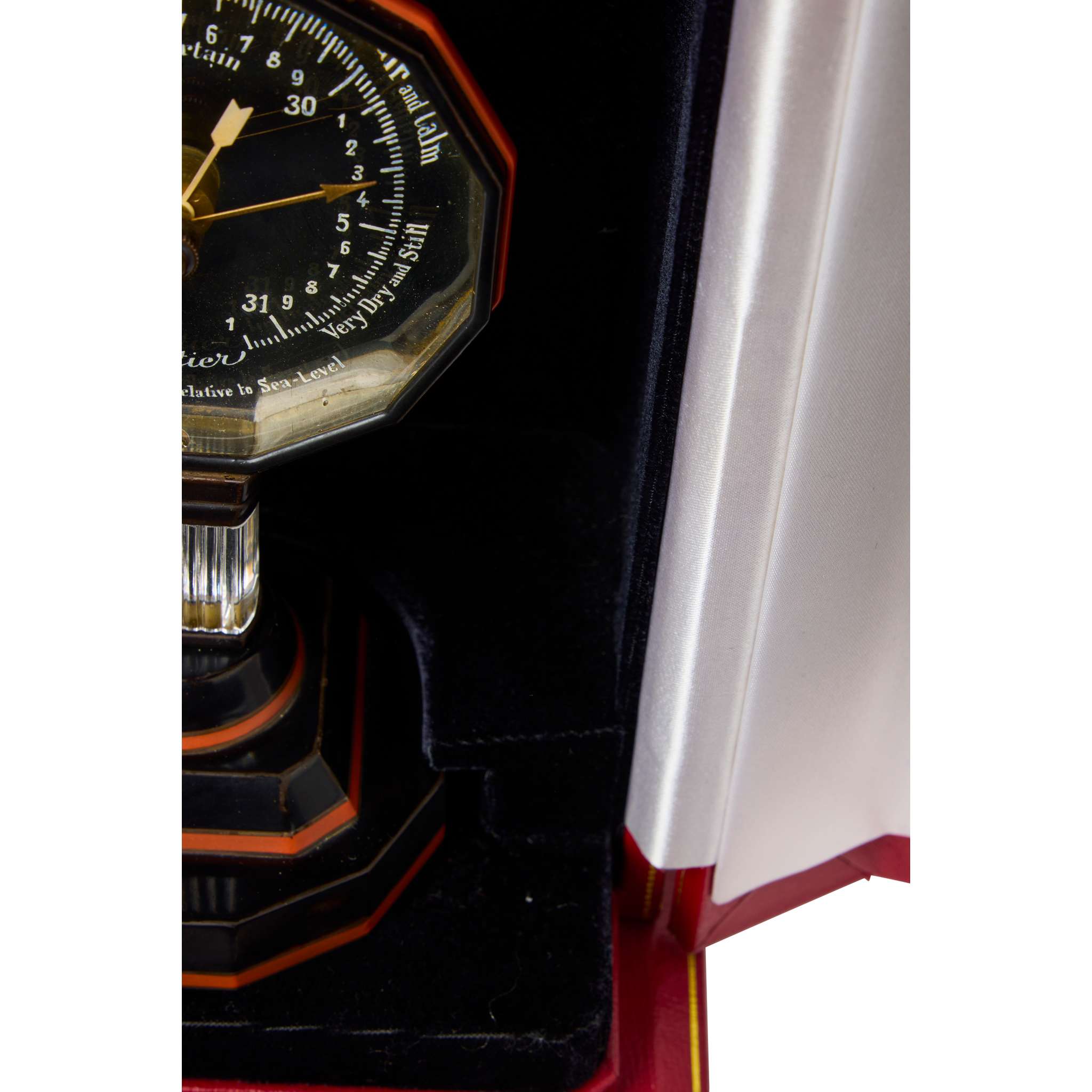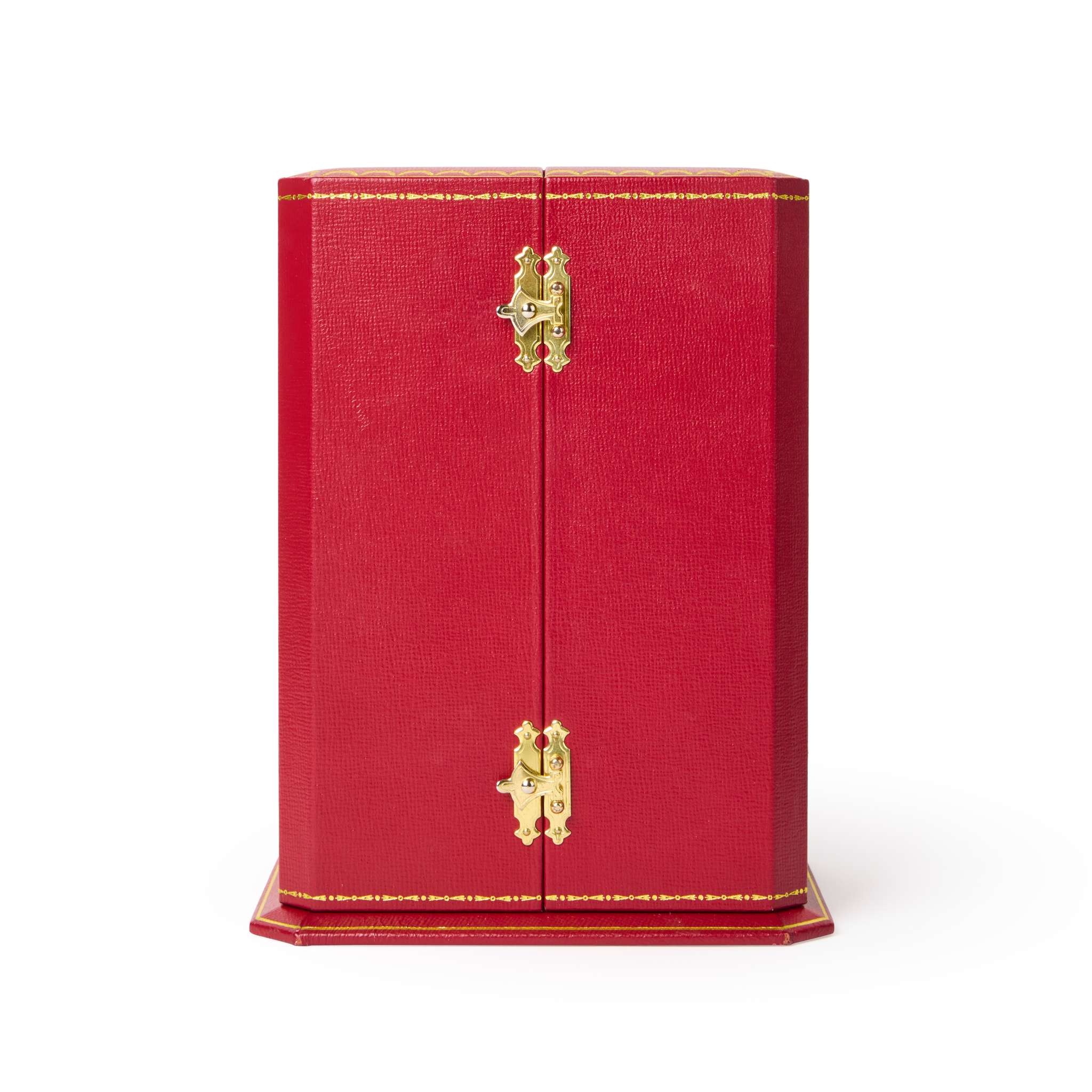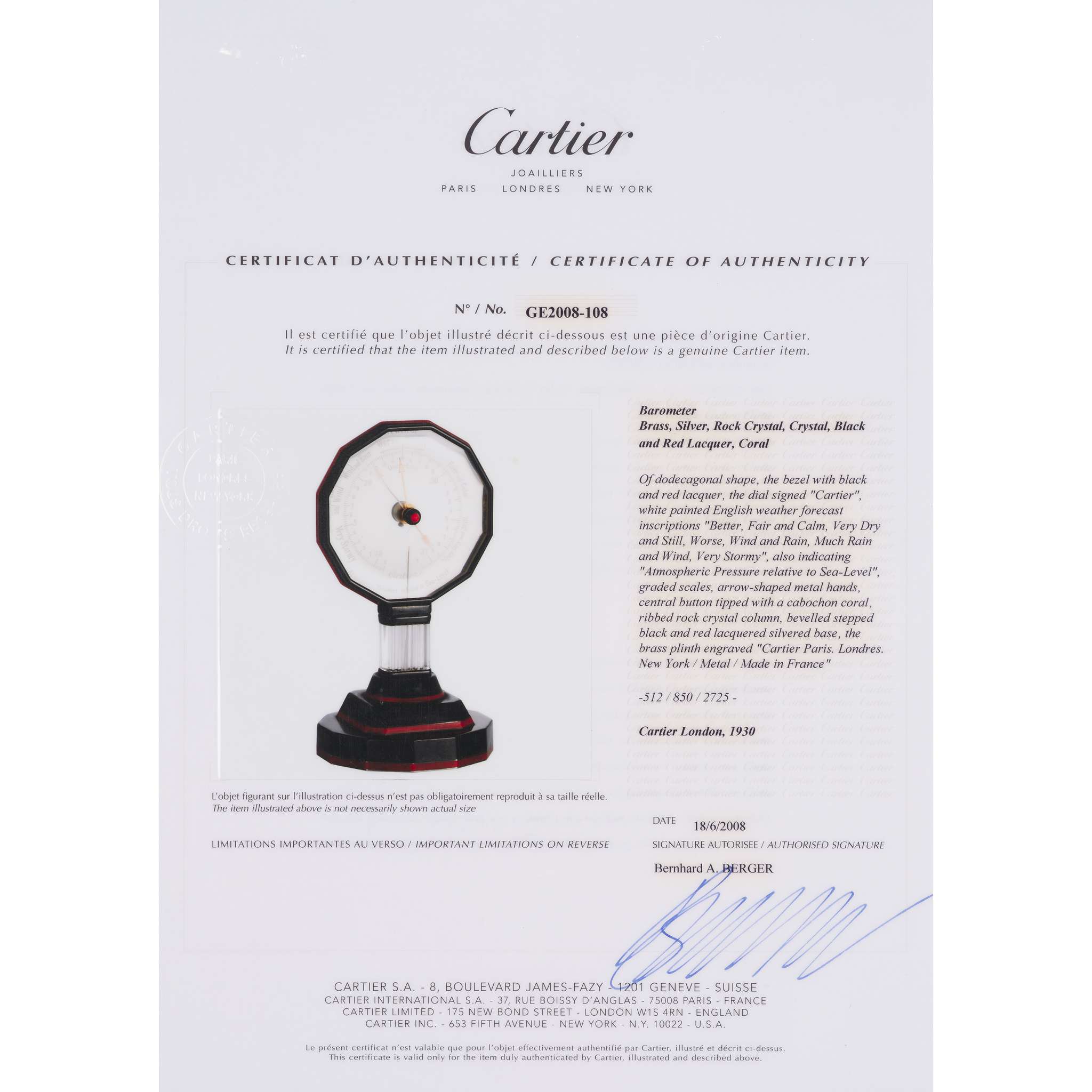7
Y Cartier: A rock crystal, silver, corallium rubrum, black and red lacquer demi-Mystery barometer
Almost certainly unique. No. 2725, 1930
Dodecagon shaped transparent dial with barometer readings in white, titled ‘Weather, Worse-Better' with relevant arrows, further signed ‘Atmospheric Pressure relevant to Sea-Level’, central recording hand set via a coral corallium rubrum cabochon, atmospheric pressure displayed via a central hand connected via a chain through a rock-crystal pedestal to the aneroid barometer movement within the base. Brass bottomplate, black and red lacquer base and upper edge. Dial signed, baseplate signed Cartier Paris Londres New York, Made in France, and numbered. Height 15.2cmAccompanied by a later fitted case as well as a Cartier Certificate of Authenticity signed by Bernhard A. Berger stating that the barometer is a genuine Cartier item, sold by Cartier London, 1930. Certificate dated 2008.
Although Cartier mystery clocks are exceedingly rare and highly sought after, very few barometers are known to have been made. An almost identical example, very possibly the twin of this version, in the same design except with black dial text in French, was sold by Christie's in 2011. Following the early success with the Santos wristwatch, Louis Cartier began to focus more on the creation of wristwatches and clocks. In 1911 he hired Maurice Couët with whom he would go on to design and manufacture some of the most innovative clocks ever made. Louis’ idea for the “Mystery Clock” was a transparent clock where the hands seemed to hover in mid-air devoid of an elaborate dial. It took over a year for the Parisian workshop to create a clock Louis was happy with. The first models appeared in 1912. They mystery of how they worked was a such a closely guarded secret that even the Cartier sales team were not informed; hence their genuine wonder was communicated to potential buyers. Couët's team used fine rock crystal to created the see through dial and placed the mechanism in the base. By dedicating a whole year to the creation of an item, the final cost was understandably substantial. Unsurprisingly then J.P. Morgan, the American financier and banker, was one of the first to buy the new creations.The technical difficulties of adapting a clock housing to suit the functionality of a barometer were notable and could explain why this example is a “demi mystery” with a thin line visible connecting the hands to the base. Cartier sourced barometer components from Europe to fit into the form of the mystery clocks being made at this time.This particular barometer follows the form of the second type of clocks made. “The second type, with a central axle and a dial that was often hexagonal in shape… was made from 1920 to 1931.” see Chapman, Martin, Cartier and America, the Fine Art Museums of San Francisco, 2009, page 147. Therefore it's plausible to suggest this barometer was made in the Couët workshop.
Almost certainly unique. No. 2725, 1930
Dodecagon shaped transparent dial with barometer readings in white, titled ‘Weather, Worse-Better' with relevant arrows, further signed ‘Atmospheric Pressure relevant to Sea-Level’, central recording hand set via a coral corallium rubrum cabochon, atmospheric pressure displayed via a central hand connected via a chain through a rock-crystal pedestal to the aneroid barometer movement within the base. Brass bottomplate, black and red lacquer base and upper edge. Dial signed, baseplate signed Cartier Paris Londres New York, Made in France, and numbered. Height 15.2cmAccompanied by a later fitted case as well as a Cartier Certificate of Authenticity signed by Bernhard A. Berger stating that the barometer is a genuine Cartier item, sold by Cartier London, 1930. Certificate dated 2008.
Although Cartier mystery clocks are exceedingly rare and highly sought after, very few barometers are known to have been made. An almost identical example, very possibly the twin of this version, in the same design except with black dial text in French, was sold by Christie's in 2011. Following the early success with the Santos wristwatch, Louis Cartier began to focus more on the creation of wristwatches and clocks. In 1911 he hired Maurice Couët with whom he would go on to design and manufacture some of the most innovative clocks ever made. Louis’ idea for the “Mystery Clock” was a transparent clock where the hands seemed to hover in mid-air devoid of an elaborate dial. It took over a year for the Parisian workshop to create a clock Louis was happy with. The first models appeared in 1912. They mystery of how they worked was a such a closely guarded secret that even the Cartier sales team were not informed; hence their genuine wonder was communicated to potential buyers. Couët's team used fine rock crystal to created the see through dial and placed the mechanism in the base. By dedicating a whole year to the creation of an item, the final cost was understandably substantial. Unsurprisingly then J.P. Morgan, the American financier and banker, was one of the first to buy the new creations.The technical difficulties of adapting a clock housing to suit the functionality of a barometer were notable and could explain why this example is a “demi mystery” with a thin line visible connecting the hands to the base. Cartier sourced barometer components from Europe to fit into the form of the mystery clocks being made at this time.This particular barometer follows the form of the second type of clocks made. “The second type, with a central axle and a dial that was often hexagonal in shape… was made from 1920 to 1931.” see Chapman, Martin, Cartier and America, the Fine Art Museums of San Francisco, 2009, page 147. Therefore it's plausible to suggest this barometer was made in the Couët workshop.
Cartier Curated
Sale Date(s)
Venue Address
General delivery information available from the auctioneer
Our saleroom team are always on hand to help, whether you are collecting in person or require advice about recommended carriers.
If you attend an auction in person and are successful in your bid, you are free to collect and remove your item there and then once payment has been cleared. If you are not able to do so we are happy to recommend a number of carriers who will be able to arrange packing and shipping for you. Please contact them directly to receive a quote for costs. You are, of course, very welcome to use an alternative courier.
UK & International - Smaller items and paintings
Mailboxes Etc
44/46 Morningside Road
Edinburgh, EH10 4BF
Tel: 0131 556 6226
info@mbeedinburgh.com
www.mbe.co.uk/auctionroom
Mailboxes Etc
8 Shepherd Market
Mayfair
London, W1J 7JY
Tel: 0207 491 0022
info@mbemayfair.co.uk
Mailboxes Etc
61 Praed Street
London, W2 1NS
Tel: 0207 706 3666
info@mbepaddington.co.uk
Pack & Send Edinburgh East
53 Elm Row
Leith Walk
Edinburgh, EH7 4AH
Tel: 0131 201 2244
edinburgheast@packsend.co.uk
www.packsend.co.uk/edinburgheast
Local Deliveries - Larger items
A&S Pert Removals
Tel: 07876 343520
New Leaf Removals
Tel: 07999 926261
UK & International - Larger items
Aardvark Art Services Ltd
Tel: 01253 794 673
info@aardvarkartservices.com
Constantine Moving Services (Specialists in UK & International Shipping)
Constantine House
North Caldeen Road
Coatbridge, ML5 4EF
Tel: 01236 430 681
allanak@constantinemoving.com
A Van Man Transport
Unit 5, Benridge Park
Holyrood Close, Creekmoor
Poole, Dorset, BH17 7BD
Tel: 01202 600 012
office@avmt.co.uk
Gallery Support Group
Unit 4, 89 Manor Farm Road
Wembley
London, HA0 1BA
Tel: 020 305 307 53
info@gallerysupportgroup.com
Important Information
BUYER'S PREMIUM
The buyer shall pay the hammer price together with a premium, at the following rate, thereon.
26% up to £20,000
25% from £20,001 to £500,000
20% thereafter
VAT will be charged on the premium at the rate imposed by law (see our Conditions of Sale at the back of this catalogue).
ADDITIONAL VAT
† VAT at the standard rate payable on the hammer price
‡ Reduced rate of 5% import VAT payable on the hammer price
[Ω] Standard rate of import VAT on the hammer price
Lots affixed with ‡ or [Ω] symbols may be subject to further regulations upon export /import, please see Conditions of Sale for Buyers Section D.2.
No VAT is payable on the hammer price or premium for books bought at auction
REGISTRATION
All potential buyers must register prior to placing a bid. Paddle registration must be completed in advance of the sale day. Please note that all first-time, and those returning after an extended period, bidders at Lyon & Turnbull will be asked to supply the following documents in order to facilitate registration:
1 – Government issued photo ID (Passport/Driving licence)
2 – Proof of address (utility bill/bank statement).
By registering for the sale, the buyer acknowledges that he or she has read, understood and accepted our Conditions of Sale.
ARTIST’S RESALE ROYALTY (DROIT DE SUITE)
§ indicates works which may be subject to the Droit de Suite or Artist’s Resale Right, which took effect in the United Kingdom on 14th February 2006. We are required to collect a royalty payment for all qualifying works of art. Under new legislation which came into effect on 1st January 2012 this applies to living artists and artists who have died in the last 70 years. This royalty will be charged to the Buyer on the Hammer Price and in addition to the Buyer’s Premium. It will not apply to works where the Hammer Price is less than £1,000. The charge for works of art sold at and above £1,000 and below £50,000 is 4%. For items selling above £50,000, charges are calculated on a sliding scale. All royalty charges are paid to the Design and Artists Copyright Society (‘DACS’) and no handling costs or additional fees are retained by the Auctioneer. Resale royalties are not subject to VAT.
More information on Droit de Suite is available at www.dacs.org.uk
REMOVAL OF PURCHASES
Responsibility for packing, shipping and insurance shall be exclusively that of the purchaser. See Collections & Storage section for more info specific to this particular auction.
COLLECTION OF PURCHASES (SALE 855 CARTIER CURATED)
All purchases can be collected from our London venue, by appointment, from 29th April onwards.
Lyon & Turnbull, 22 Connaught St, London, W2 2AF
Tel 020 7930 9115 | london@lyonandturnbull.com
CATALOGUE DESCRIPTIONS
All item descriptions, dimensions and estimates are provided for guidance only. It is the buyer’s responsibility to inspect all lots prior to bidding to ensure that the condition is to their satisfaction. Our specialists will be happy to prepare condition reports and additional images. These are for guidance only and all lots are sold ‘as found’, as per our Conditions of Sale.
IMPORT/EXPORT
Prospective buyers are advised that several countries prohibit the importation of property containing materials from endangered species, including but not limited to; rosewood, rhino horn, ivory, coral and tortoiseshell. Accordingly, prospective buyers should familiarise themselves with all relevant customs regulations prior to bidding if they intend to import lots to another country. It is the buyer’s sole responsibility to obtain any relevant export or import licence. The denial of any licence or any delay in obtaining licences shall neither justify the recession of any sale nor any delay in making full payment for the lot.
ENDANGERED SPECIES
Please be aware that lots marked with the symbol Y contain material which may be subject to CITES regulations when exporting outside Great Britain. For more information visit https://www.defra.gov.uk/ahvla-en/imports-exports/cites
Terms & Conditions
UK - Conditions Of Sale For Buyers
These Conditions of Sale and the Saleroom Notices as well as specific Catalogue terms, set out the terms on which we offer the Lots listed in this Catalogue for sale. By registering to bid and/or by bidding at auction You agree to these terms, we recommend that You read them carefully before doing so. You will find a list of definitions and a glossary at the end providing explanations for the meanings of the words and expressions used.
Special terms may be used in Catalogue descriptions of particular classes of items (Books, Jewellery, Paintings, Guns, Firearms, etc.) in which case the descriptions must be interpreted in accordance with any glossary appearing in the Catalogue. These notices and terms will also form part of our terms and conditions of sales.
In these Conditions the words “Us”, “Our”, “We” etc. refers to Lyon & Turnbull Ltd, the singular includes the plural and vice versa as appropriate. “You”, “Your” means the Buyer.
Lyon & Turnbull Ltd. acts as agent for the Seller. On occasion where Lyon & Turnbull Ltd. own a lot in part or full the property will be identified in the catalogue with the symbol (
























